Brian E. Boyd Sr.'s Blog, page 11
July 9, 2014
Why the “Guess the Emoji” Game is Brilliant
The game “Guess the Emoji” is all the craze, which is why it is placed as the #1 free app download on iTunes. Now, I’m not usually into the latest phone games (I think the last game I was highly addicted to was “Draw Something”), but this caught my eye. “Guess the Emoji” was set up in a brilliant way. Here’s how:
Surprisingly, the simplicity of the game makes it easy to play and highly addictive, targeting any and all audiences. It follows a similar theme to Pictionary, where two emoji icons appear on the screen, and you have to guess what words/phrase it spells out.
It’s pretty simple, and nothing special that’s for sure. But what struck me was the engagement level on Facebook. If you are stuck on a puzzle, you can “Ask Facebook”, which then posts the picture to Facebook and you are able to reach out to your friends for help. I saw these images pop up several times on my newsfeed, making me curious about this game everyone was playing, so I downloaded it and joined the crowd.
Usually games are separate from social media, but this game actually encourages you to use social media. And if you are stuck on a puzzle, you’ll definitely use the “Ask Facebook” feature, receiving the answer within minutes from your friends. This does one of two things:
Encourages Viral Ability. Once one Facebook friend sees a “Guess the Emoji” game post, they unconsciously “play” the game by commenting on what the answer might be. Then the curiosity for more encourages them to download, share with their friends on Facebook, and the cycle continues. Social sharing fuels the popularity of the game, which encourages downloads. It’s an easy recipe for a viral game.
Encourages Engagement. Doesn’t everyone nowadays want people talking (positively) about their brand on social media? That’s exactly what “Guess the Emoji” accomplished. By sharing to Facebook, you are inviting your friends to play along with you by commenting on the puzzle photo. This not only ramps up interaction numbers, but also offers an opportunity for ROR (Return on Relationship).
This now opens a door for more games to offer a Facebook or social media engagement option in general. If games keep following this structure, we will see more and more games merge with the social media world.
Should your brand incorporate gaming into your social media strategy? Talk with us: https://www.facebook.com/MediaConnectPartners
This post was written by Sarah Boyd. Sarah is a Social Media Specialist with Media Connect Partners.
The Art of Listening
Often times we like to blow our own horn more than step back and listen to the music, after all your horn is the most important right? No one likes someone who controls the conversation and only likes hearing his or her voice. There seems to be a misconception that to be in control of the conversation you must be the one talking. This misunderstanding often times carries over into social media practices as well.
You might have heard that to be successful with social media efforts you must engage. Engagement does not just mean extending your oratory skills to the digital realm, but it must also incorporate listening. Listening to what is being talked about and responding in a timely manner. Learning through listening to what people are saying about your brand or industry is important and plays a big role in good social media strategy.
There are a couple ways that listening through social media shows its power.
It spurs ideas for product development.
It provides competitive insight.
It will help control brand reputation.
When you take the time to listen to what is being said you can locate and identify your biggest fans as well as keep a close eye on what competitors are up to.
Learning through listening has great power and can pay off in the long run in social media. So put your ear to the ground and listen, you never know how and when it will pay off.
This post was written by Chandler Elmore. Chandler is a Social Media Specialist with Media Connect Partners.
July 2, 2014
The Great Social Media Debate
I had an interesting talk with a client recently. He asked me a very poignant question in three parts,
Should we even bother with Facebook anymore or social media in general?
Social media is now “pay-to-play,” is it worth it?
Will our clients actually be searching for us on social media?
Way to put a girl on the spot! Just kidding. I’ve been asked those questions many times and thankfully the answer is a simple one, “Yes.” Yes, social media still matters. Yes, even though it’s pay-to-play it’s still worthwhile. Yes, your clients will use social media when “vetting” you out.
Yes, you should use social media.
No, social media is not on its way out. In fact, every day it seems like there are new social media platforms, updates, and ideas that are gaining speed. Social media has only just begun and it is here to stay. Facebook, Twitter, Instagram, SnapChat, YouTube, etc. all of these platforms are only continuing to grow in users day after day, week after week, month after month, and year after year. Social media has become a cultural norm and if you don’t participate or understand how to use it for yourself, you’re going to be left out in the cold.
There are many websites and resources available to you to help you understand how you can use social media for yourself. Read our blog. Check out the website mashable.com. Google, “Should I use social media and how?” The information is out there and it will all point you in the same direction. Social media is still relevant and you need to be on it.
Yes, just because you have to “pay-to-play” doesn’t mean you should give up.
Social media should be budgeted just like any advertising or marketing dollars. Yes, Facebook used to be free, but that was long before Facebook had 1.3 billion, yes you read that right, BILLION users worldwide. Would you not put your product on a TV commercial just because they charge you for it? Let me ask you, would your TV commercial reach 1.3 billion people?
We need to start looking at social media differently. Yes, the Facebook algorithm makes it more difficult for your posts to show up organically for free to your users, but that’s the cost of advertising. You don’t put up a billboard or craft a magazine advertisement for free. If you want to reach your audience and make an impact on your consumer, you have to be willing to pay for it. And it’s worth it. With Facebook, more so than traditional advertising, you can target your ads and content to reach the exact demographic and audience who best suits you. You can even target down to what your fans purchase. Where else do you get that?
Yes, your clients will use Facebook to find you and vet you.
If you’re thinking, “I’m a technology company, my clients aren’t going to go on Facebook to find me,” think again. No, maybe your client won’t hop onto Facebook and type, “Technology company in Florida” and hope that the results are good. However, that doesn’t mean that Facebook or Twitter won’t come into play. Maybe your client will search Google, find your company and a few other companies. Then, it’s decision time. How do they decide who they should choose? This is where your social media can and will come into play.
Just as people use Yelp for reviews, we use Facebook and Twitter to vet out if your legitimate. If you know what you’re talking about, then you’re someone we want to work with. In fact, I personally will not purchase from a company if I see that they are irresponsive to their customers on social media. How can I trust a company’s customer service if they don’t take care of their customers on a very public forum?
Don’t fool yourself into thinking it doesn’t matter. It does. In this day and age, social media is the new “go-to.”
Learn it.
Use it.
Make it work for you.
This post was written by Kelly Vo. Kelly is an Account Director with Media Connect Partners.
Which Summer Trends Should Your Christian Business Adopt?
Now that summer’s here, get ready for your newsfeed to be flooded with fun summer trends like vacation sunsets, beach selfies and backyard DIY projects. It might even be a good idea for your business to hop on the summer social media band wagon. Here are 5 hot ideas to help your brand stay cool this summer:
Videos: With Vine and Instagram’s video function becoming even more popular, take a simple snapshot to the next level. Next time your business has a flash sale this summer, create your own 6-15 second video showing the goods. While Vine has really flourished in the social media world, Instagram still offers longer videos (up to 15 seconds) and vintage filters. However, don’t let a nice “long” 15 second video fool you; your audience might have a short attention span, so keep your posts short and sweet.
Let Customers Check In: Location-based apps become very popular in the summer, so if your business is located by a tourist hot-spot, it’s a good idea to open an account on Foursquare and create a “check-in” for your shop. Once you set up your business’ check-in, you can start rewarding customers just for visiting your store! If you own a restaurant, you can offer appetizers to loyal customers who have checked in several times, or offer a small discount to people who have just discovered your shop.
Pair summer contests with a trendy hashtag: Getting ready to launch a summer contest? Don’t forget the hashtag! Be creative and come up with an easy-to-remember hashtag so your audience can upload and quickly enter your giveaway. Creating a unique hashtag will also help you chose a winner. By clicking your hashtag, you instantly have access to everyone who used the hashtag to enter your contest. All you have to do is pick the lucky winner.
Get mobile-friendly: With people spending more time outside and less time on their computers, make sure all your content is mobile-friendly. Double check any links before posting to social on your mobile device so no one misses your great announcements. If you choose to launch any giveaways or contests, make sure they’re primarily mobile-based, so use apps like Foursquare and Instagram, over Facebook.
Take advantage of major summer events: 4th of July, summer music concerts, even the World Cup. Take advantage of events that happen in the summer and create content that links your brand or business to events that happen in the real world and connect with your community. Is there a major music festival going on in your town? Does it seem like your team will make it all the way in Brazil this year? A simple post humanizing your brand can go a long way.
It’s summer, the perfect time to kick back and enjoy all the new social trends to connect with your customers. The best thing you can do for your customers is to make sharing their experience THAT much easier.
This post was written by Eileen Perez. Eileen is a Social Media Specialist with Media Connect Partners.
June 26, 2014
Facebook changed….again!
Follow along with the images below—pay attention to the darkened areas as these represent the specific area we are focusing on in each image.
Where can you find your content—your daily updates?

Where can you find your page “like” information and/business information?

Where are your tabs—those helpful landing pages full of information?
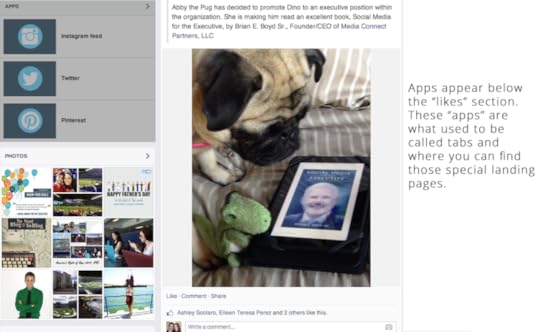
Where are your photos and videos?

Where can you find posts written by your fans on your page?

What happened to the top of your page? What are all the new buttons?
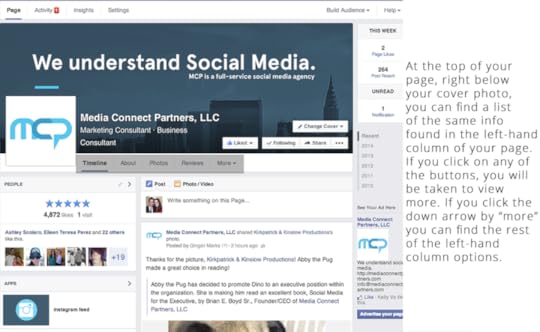
Where is all the useful admin information like insights and data?

The new page looks different, but you still have all the same great information and ability.
If you have any questions about these updates, please don’t hesitate to reach out to us here at MCP and we would be happy to help. Just click on our “Contact Us” page!
June 25, 2014
Christian Stereotypes in Social Media (and how to avoid them)
Christian content in the social media world is rare. You’re more likely to see a Buzzfeed top 10 article on your timeline, or the latest gossip on the Jay-Z and Solange situation than a prayer or testimony. But, on the slight chance that we do see Christian content, it usually makes us want to roll our eyes. Admit it.
“Jesus doesn’t love you if you don’t share this.” “Like this if Jesus is in your heart.” Or “Don’t let the devil win! Share this post for Jesus!”
Give. Me. A. Break. This can’t be real, but unfortunately it’s true. So how can we write good content that is meaningful and useful for Christians?
First, you need to establish what stereotypes you want to avoid. Maybe it’s the idea of asking for shares/likes. Maybe it’s the idea of exploitation (unethically using a picture of a starving child to gain a social following). Or maybe it’s the idea of being a money hungry church/organization. Whatever stereotypes may exist, put them on a list, and STAY AWAY from them.
Second, understand who your audience is. Is your audience Christian, or are you trying to get them to accept Jesus Christ into their hearts? Those two audiences are completely different. For an audience that does not know Jesus, content should be very basic. But for already established Christians, you can dive deep into many Christian topics. By knowing exactly who your audience is, you can focus on content that actually matters and avoid the clichés and stereotypes.
Finally, keep your mission close to heart. WHY do people want to follow your social accounts? Is it because the scriptures resonate with your audience? Or the daily devotional videos give a great perspective to start out the day. Whatever “it” is, remember it! Many Christian brands lose sight of this – and their content reflects it. You don’t want to appear all over the place with random content—you want to be the resource that someone needs to bring them closer to God. The main thing is to stay true to your mission, if you do this, stereotypes shouldn’t be a problem.
This post was written by Sarah Boyd. Sarah is a Social Media Specialist with Media Connect Partners.
Social Media Tips & Tricks: What I’ve Learned This Year (so far)
Given that social media consumes such a large part of our lives, I’m always up for finding new ways to get the most out of it, both personally and professionally. Here are some of the most helpful tips I’ve discovered in 2014 so far:
YouTube subscriber’s trick: The main goal of any YouTube channel is to grow its subscriber base. Thanks to a great blog post on Gleam, I found an awesome semi “hack.” Allegedly, this trick can increase subscriber rate by 400%.
By simply adding < ?sub_confirmation=1 > to the end of your YouTube channel URL, anyone who visits your channel via that link will automatically receive a pop up prompting them to subscribe to the channel. Think of this as a pseudo Facebook “fan gate.”
Note: This only works when linking to your channel page, it does not work for linking to your individual YouTube videos.
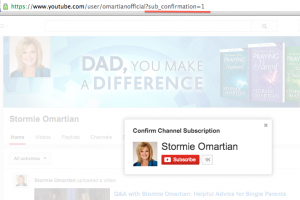
Twitter images tip: Pic.twitter.com versus ow.ly links. There’s been a huge surge in the popularity of images on Twitter. Studies have shown that including an image can even double your retweets. But, when you go to tweet out that fun picture of you and Fido at the dog park, make sure you’re doing it right! (If you only use Twitter.com to send out tweets, congratulations! You’re in the clear.)
But, anyone using third-party sites like Hootsuite or Crowdbooster, this one’s for you: Many third-party scheduling platforms use ow.ly or other shorteners to tweet out your image as a link. This forces users to have to click on the link just to see the image. If using Hootsuite, there’s no way to work around this yet, which means all you H.S. users are better off posting and scheduling tweets with images through Twitter.com, which allows images to appear directly in the timeline using pic.twitter.com links.
Another solution is Crowdbooster, which can also post images using pic.twitter.com links – but beware! Crowdbooster automatically selects the option to “shorten links using ow.ly” – which is exactly what you need to avoid – so be sure to uncheck that option.
Ow.ly

Pic.twitter.com
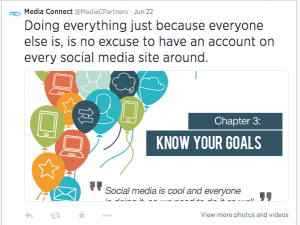
Twitter Cards trick: A new feature allowing you to “attach rich photos, videos and media experience to Tweets that drive traffic to your website.” This is the perfect workaround for anyone who’s ever wanted to include both an image and a URL in their tweets without the unfavorable look of two links in one tweet. With the “website card” you can basically create Twitter’s version of a Facebook “link post” – allowing you to upload a link preview image that links to your website.
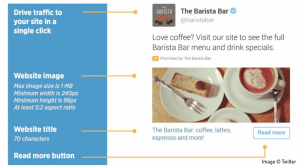
Instagram tip: Square photos can be great – but not all images look best with a 1:1 aspect ratio. If you’ve got a killer picture but using the default Instagram size takes away from the overall “wow” factor – use an app like Whitagram, which allows you to use the original size of the image with a clean, white background.

Is there anything you can add? What tips and tricks have you learned while using Social Media this year?
This post was written by Jackie Silva. Jackie is a Social Media Specialist with Media Connect Partners.
June 18, 2014
Top 5 Things Your Company Should Avoid in Social Media
You might feel that social media has no rules, that anything goes, but that couldn’t be farther from the truth. There is always going to be rules, etiquettes, and things to avoid, here are five important ones.
1. Not planning ahead.
So many companies jump right into social media because everyone tells them they should, but they skip the important process of research and planning. It’s vital that you take the time to get to know the social platforms you are joining and develop a clear, actionable plan with ROI for each.
2. Over-sharing.
You want to get the important information out about your product and service, but sharing 5-10 times a day is going to easily annoy your followers and cause a lot of them to stop following you. The best thing your company can do is to create a content calendar so you can easily spread out your content and have a bird’s eye view of what you are sharing.
3. Ignoring Everyone.
I see it all the time. A company asks their followers a question and then ignores all the responses. Don’t ignore your customers, you asked them a question, they responded-get back in there and engage!
4. Connecting Facebook to Twitter.
Look, I get it, you have a lot to do and not enough time in the day, but the least you can do is not automatically send your Facebook posts to Twitter. If you do this, it’s a clear sign you’re not really engaged on Twitter and most of the time too many characters are used than allowed on Twitter.
5. Liking Your Own Posts.
So you’ve just posted an amazing picture of some recent work your company has done or a great new product offering. That’s great, I guess. But then you go ahead and like your photo/status too. Well, we know you already like the post, aren’t you the one who just shared it? It’s like giving yourself a high five-not cool and very obnoxious.
This post was written by Matt Gregory. Matt is the VP of Operations for Media Connect Partners.
Behind The Scenes at #WikiConUSA
 A couple of weeks ago, I had the pleasure of attending WikiConference USA in New York City, The Wikimedia Foundation’s 2014 USA conference. This conference was packed with seminars, workshops, and keynotes covering some of the top trends in Wikipedia right now. Read the highlights from my weekend at #WikiConUSA:
A couple of weeks ago, I had the pleasure of attending WikiConference USA in New York City, The Wikimedia Foundation’s 2014 USA conference. This conference was packed with seminars, workshops, and keynotes covering some of the top trends in Wikipedia right now. Read the highlights from my weekend at #WikiConUSA:
The Conference #WikiConUSA offered attendees the opportunity to learn and take our editing skills to the next level! One of the most unique opportunities that I had was participating in my first edit-a-thon! Edit-a-thons are a community outreach project that take place at various meet-ups and Wiki events around the world. This edit-a-thon’s theme was “Art + Feminism”, which involved us updating various articles in the database to help them stand out amongst the others.
Fellow Wikipedians Attending #WikiConUSA took the mask off of Wikipedia. This conference brought together admins, editors, and Wikipedians from all over the United States to New York City! This event was truly a melting pot, which is what made it fun. I learned new tricks from some of the experts, shared insight in a safe learning environment, and even lead an “un–conference” discussion with new friends about Social Media and Wikipedia.
The Foundation This conference was sponsored by The Wikimedia Foundation. The Wikimedia Foundation supports some of the most valued events like WikiConference in cities all over the world. The foundation also supports educating youth about Wikipedia through their Wiki Education Foundation. Foundation staff gave insight to attendees about how Wikipedia plans to grow in the years ahead.
Media Connect Partners, LLC sponsored WikiConference USA by contributing live social media coverage throughout the event. This blog was written by Jordan Moran. Jordan Moran is a Social Media Specialist with Media Connect Partners.
June 11, 2014
Lessons Learned from Celebrity Endorsements on Social Media
A few weeks ago, Beyoncé posted two Instagram photos featuring the book cover and a prayer from one of our MCP: Faith clients, Stormie Omartian’s Christian book, “Power of a Praying Woman.” To a social media expert, this kind of thing is huge, and has great potential to promote client awareness. To a believer, it’s an even bigger deal, given that someone with a follower base of more than 12 million people shared God’s Word with all of their followers – potentially inspiring them to read a book that has the sole purpose of bringing people closer to Christ.


Our team of specialists quickly set out to recognize Beyoncé’s virtual endorsement, posting on the appropriate social media platforms and responding back to Beyoncé by tagging her accounts.

Although we received a lot of positive feedback, we knew walking in that there was a potential for backlash from our client’s fan base if they were to misrepresent our sharing of the news as an endorsement of that celebrity’s lifestyle and secular music.
Here are four lessons learned from Beyoncé posting a prayer from Stormie Omartian’s, “Power of a Praying Woman©” on Instagram:
Always think before you act! Our team thought out the pros and potential cons of sharing a secular artist’s endorsement to a fan base of strong believing Christians. We planned accordingly and made sure that doing so would not go against our client’s principles and beliefs, or our own. And if you have a doubt, always check with the client first.
It’s tried and true: “Hope for the best, expect the worst.” Because our team anticipated the potential for negative responses from our client’s fans, we were prepared and had a response plan ready to address those issues.
Don’t ignore negative feedback: be transparent. Maintaining a close and authentic relationship between our client and their audience is one of our top priorities. We actively replied back to all fans that had concerns or objections, clearly and transparently explaining the thoughts and motives behind our actions – not condoning or supporting the musical artist, simply being thankful that God’s Word was shared with so many people.
*You’d be surprised at how quickly you can change a fan’s anger into understanding if you just thoroughly and truthfully explain a situation. The majority of our fans who were initially troubled or upset were soon either in agreement or much more understanding once we explained our heart-felt reasoning.
Lastly, closely monitor social media. If it weren’t for our MCP: Faith team always keeping their eyes and ears open, scanning all social media sites regularly, we might not have known about Beyoncé’s Instagram photos until hours or days after, if it all. Keep in mind that for platforms like Instagram, search results can only find written content and hashtags; you can’t search for text found in photos!
So if you want a team of professionals who lives and breathes your ministry, and doesn’t miss a beat when it comes to helping you succeed and share the gospel—contact MCP: Faith today at mcpfaith@mediaconnectpartners.com
This post was written by Jackie Silva. Jackie is a Social Media Specialist with Media Connect Partners.
Brian E. Boyd Sr.'s Blog
- Brian E. Boyd Sr.'s profile
- 5 followers



